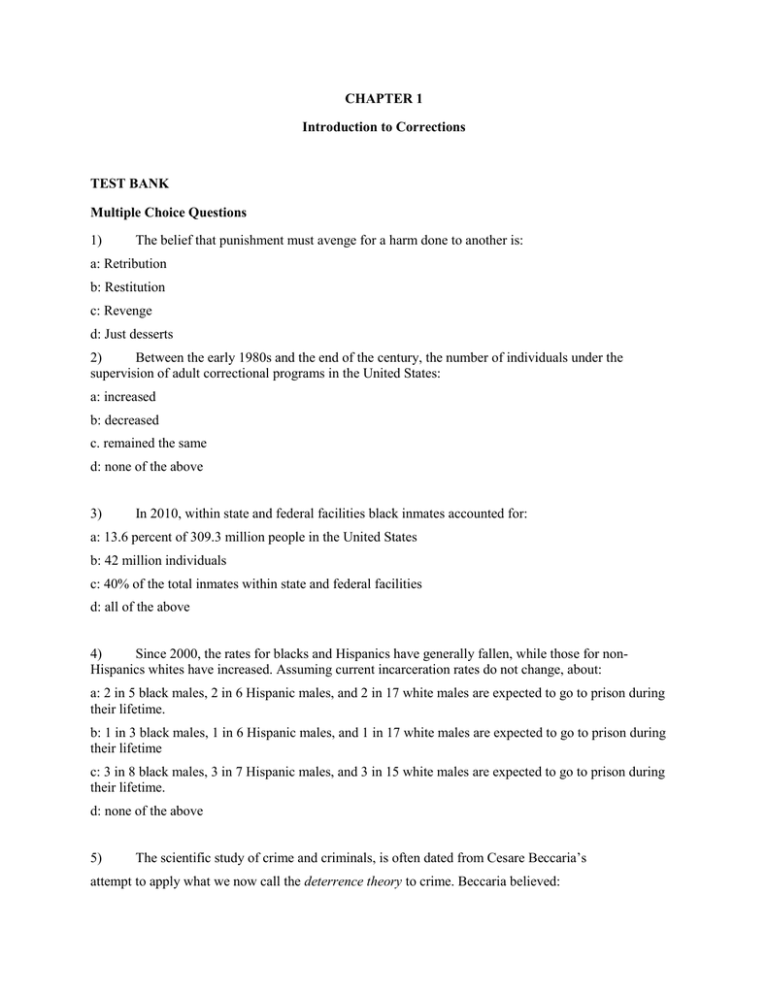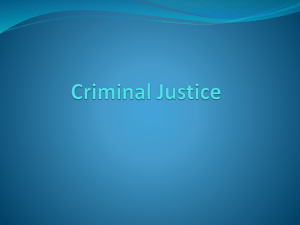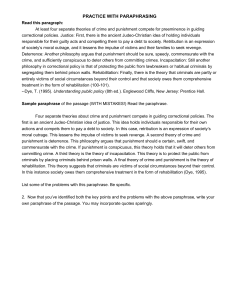CHAPTER 1 Introduction to Corrections TEST BANK Multiple Choice
advertisement

CHAPTER 1 Introduction to Corrections TEST BANK Multiple Choice Questions 1) The belief that punishment must avenge for a harm done to another is: a: Retribution b: Restitution c: Revenge d: Just desserts 2) Between the early 1980s and the end of the century, the number of individuals under the supervision of adult correctional programs in the United States: a: increased b: decreased c. remained the same d: none of the above 3) In 2010, within state and federal facilities black inmates accounted for: a: 13.6 percent of 309.3 million people in the United States b: 42 million individuals c: 40% of the total inmates within state and federal facilities d: all of the above 4) Since 2000, the rates for blacks and Hispanics have generally fallen, while those for nonHispanics whites have increased. Assuming current incarceration rates do not change, about: a: 2 in 5 black males, 2 in 6 Hispanic males, and 2 in 17 white males are expected to go to prison during their lifetime. b: 1 in 3 black males, 1 in 6 Hispanic males, and 1 in 17 white males are expected to go to prison during their lifetime c: 3 in 8 black males, 3 in 7 Hispanic males, and 3 in 15 white males are expected to go to prison during their lifetime. d: none of the above 5) The scientific study of crime and criminals, is often dated from Cesare Beccaria’s attempt to apply what we now call the deterrence theory to crime. Beccaria believed: a: that forces beyond the individual’s control were the source of criminal behavior b: without certain and swift punishment that accords the unwanted act the required amount of severity, some people simply choose crime c: that people are rational beings endowed by their creator with free will and so are responsible for their own actions d: b & c 6) Modern biological determinism proponents insist that certain criminal behaviors have their origins in: a: biochemical imbalances b: defects in the mind c: the idea that all behavior is the result of learned responses to various stimuli d: none of the above 7) The deterrence philosophy assumes that certain and severe punishment can: a: only increase future crime by the offender b: decrease future crime by the offender c: discourage future crime by the offender and by others d: has virtually no impact upon crime by the offender 8) Rehabilitation is not based on the notion that people (whatever their age or their crime) can: a: choose differently through various treatment and counseling programs b: change c: just say “no” to crime d: become less likely to engage in criminal behavior if they undergo psychological and educational training. 9) At the center of selective incapacitation lies the assumption that: a: that there is a finite number of high-rate criminals b: career criminals can be identified early on, as preteens or teens c: criminals are open to interpretation and challenge d: all of the above 10) In the criminal justice field the current public policy direction regarding crime today is to: a: lessen the penalties and focus on rehabilitation b: become harsher as leniency contributes to criminality and the only response to increased criminality is tougher punishment c: focus on restitution d: understand the social problems of young offenders 11) Biological determinism is based on the premise that: a: offenders have few choices to make because their criminal tendencies are innate b: that people are rational beings with a free will and so are responsible for their own actions c: forces in the human mind could explain criminal conduct d: b & c 12) With regard to the factors of race and IQ as determinants of crime it has been found that: a: race is most often a factor in criminal behavior b: the higher the IQ the less likely the individual has committed a crime c: most criminologists reject the race–IQ–crime equation because it is not supported by research d: race based explanations for crime have a wide level of support among criminologists 13) Biological determinists have attempted, with limited success, to link crime and hormone levels for example: a: low levels of testosterone in men and high levels of estrogen in women b: low levels of estrogen in women and high levels of testosterone in men. c: men have high levels of testosterone with no change in estrogen for women d: none of the above 14) One of the key elements of Restorative justice, or the balanced approach, is: a: Competency development as it emphasizes remediation for offenders’ social, educational, or other deficiencies when they enter the correctional system. b: Accountability as it requires offenders to repay or restore victim’s losses, much like restitution. c: Restitution as it entails “having the offender repay the victim or the community in money or services” d: a & b 15) MAO is an: a: enzyme that helps regulate several key neurotransmitters, including those in the brain b: genetic term that has been identified in criminal offenders c: enzyme that is generally lower in three groups: males, youths and young adults, and African Americans d: a & c 16) One of the oldest correctional philosophies is: a: restitution b: reintegration c: retribution d: punishment 17) A new rationale for punishment emerged in 1970s which is known as: a: retaliation b: just desserts c: retributive justice d: all of the above 18) One form of specific deterrence is: a: probation b: parole c: the death penalty d: none of the above 19) One of the key points regarding rehabilitation is: a: treatment programs work with every offender b: some programs may not work with any offenders c: some offenders cannot be rehabilitated d: b and c 20) The arousal theory recognizes that: a: defects in this area is a cause of criminal behavior b: individuals who demonstrate need in this area can be identified early in life c: some criminals have no conscience d: criminals have a higher need for arousal 21) One characteristic of a psychopath who commits crimes with no thought of conventional morality or of the consequences of their actions is that: a: they are looking to minimize their sensory stimuli b: they receive benefits from learning or punishment in most institutional environments because the environment is so stimulating c: when they take risks or commit crimes, they are looking to maximize their sensory stimulation d: when they take risks or commit crimes, they are looking to minimize their sensory stimulation. 22) Edwin Sutherland is known in criminology for: a: the differential association theory b: the arousal theory c: the rational choice theory d: none of the above 23) Akers contributed two refining points to the social learning theory that stated learning occurs through two mechanisms: a: social disorganization and cultural transmissions b: imitation and differential reinforcement c: punishment and rewards d: positive stimuli and negative stimuli 24) With regard to the super ego, August Aichhorn found that: a: the super ego takes its form as children emulate positive role models in their life b: excessive control during a child’s formative years can result in a superego that is too rigid and inflexible c: the person with a strong super ego tends to be hostile and aggressive d: individuals with a weak superego seek punishment as a way of dealing with unconscious guilt 25) In practice reality therapy while being used in corrections: a: does not hold the offender accountable for his actions b: allows the offender to develop their own moral standards c: allows the therapist to develop a close relationship with the client and also allow the use of praise and concern as reinforcers, and the withdrawal of both as punishers. d: b & c 26) The difference between incapacitation and selective incapacitation is that: a: incapacitation is focused on juvenile criminals alone b: selective incapacitation focuses on separating juvenile criminals from adult criminals c: selective incapacitation ensures that career criminals are caught, convicted, and sentenced to a significant period of incarceration d: none of the above 27) Power-based theories of crime are rooted in Marxism who believe that: a: the criminal justice system serves the interests of the wealthy b: the criminal justice system serves the interest of the workers c: the system only benefits the government d: none of the above 28) The term radical noninterventionism refers to: a: Marxism and the idea that government should not interfere in the balance of power b: society and its agents of social control should overlook minor delinquent acts to avoid labeling youngsters and possibly setting them on the path toward more serious criminality when they are older c: secure confinement abandoned as a punishment d: labels as being powerful and important for radical changes in offenders 29) Each of the U.S. correctional systems has three general categories that make up the corrections programs including: a: rehabilitation programs, reintegration’s program and parole programs b: punishment, parole and probation c: community-based programs, rehabilitation programs and reintegration programs d: community-based programs, intermediate-sanctions, and institutional-placements 30) The following is not true about intermediate-sanction programs: a: they are among the fastest-growing programs in contemporary corrections b: they are one of the stagnant programs in contemporary corrections c: split sentences and intermittent confinement are two forms of intermediate sanctions d: these programs fall somewhere between traditional probation and incarceration on the corrections continuum True/False Statements Decide whether the following are true or false. 1) The critical components of corrections in the twenty-first century are probation, parole, prisons, and jails. 2) The death penalty is not known as a form of specific deterrence. 3) An example of secure institutional confinement would be a workhouse. 4) Traditional programs of probation and parole are not examples of community-based corrections efforts. 5) Hirschi identified four types of ties between individuals and social institutions: attachment, commitment, intelligence, and belief. 6) Discriminative stimuli cast criminal behavior either in a positive light or help neutralize the undesirableness of the behavior. 7) Social ecologists said crime emerged in certain communities because of disturbed, distressed, or incomplete social connections. 8) Disproportionate minority contact (DMC) refers to the lack of probation officers for minorities within the corrections system. 9) Although women historically are underrepresented in the nation’s correctional population, their proportion is growing. 10) One of the five possibilities for the widespread increase in incarceration rates according to Roy Walmsley is a decreased fear of crime. 11) The corrections system suggests that the retributive justice philosophy has evolved into a philosophy of penal harm. 12) One of the writers that the deterrence philosophy was based upon is Cesare Beccaria. 13) An example of general deterrence is to punish the individual offender so that he or she will not commit another offense. 14) The correctional philosophy of isolation was not used as punishment. 15) Restoration recognizes that offenders have a difficult time during their return to society and need help. 16) People today perceive that correctional treatment programs as too lenient, too soft on criminals, and they call for harsher treatment. 17) The Field of Dreams theory suggests if you build a jail or prison, the inmates will come. 18) Cesare Lombroso believed that criminal tendencies were innate and are the result of biological determinism. 19) According to Freud, the ego is the part of the mind that is concerned with moral values. 20) One of the characteristics of a psychopath is that they take risks or commit crimes, because they are looking to maximize their sensory stimulation. Fill in the Blanks 1) According to the US Department of Justice_____________ “includes all government agencies, facilities, programs, procedures, personnel, and techniques concerned with the intake, custody, confinement, supervision, or treatment, or pre-sentencing or pre-disposition investigation of alleged or adjudicated adult offenders, delinquents, or status offenders.” 2) Between the early 1980s and the end of the twentieth century, the United States experienced an enormous ____________in the number of individuals under the supervision of adult correctional programs. 3) The unequal representation of blacks and Hispanics is often referred to as ______ _______ ________. 4) Cesare Beccaria believed that people are rational beings endowed by their creator with _____ _______ and so are responsible for their own actions. 5) Neopositivists argue that youngsters with low IQ scores, who later fail in school, have __________delinquency rates. 6) Historically women are underrepresented in the nation’s correctional population, statistics show that their proportion is ________________. 7) Proponents of modern biological determinism insist that certain criminal behaviors have their origins in _________ __________. 8) _______________ __________________ begins with the premise that all behavior is the result of learned responses to various stimuli. 9) The second form of a behavior modification program is built around a _________ ____________. 10) ________________ criminals receive little benefit from learning or punishment in most institutional environments because the existing stimulation barely keeps them awake. 11) According to the theorist ___________ ____________criminal values and behaviors are learned through social interactions. 12) According to the social learning theory, ___________________ involves modeling behavior after it is observed in others. 13) In regards to biochemical imbalances, the hormone, ___________ ______________ helps regulate several key neurotransmitters, including those in the brain. 14) Labeling theorists also advocate for ______________ they would like to see secure confinement abandoned as a punishment. 15) Split sentences and intermittent confinement are two forms of ____________ _____________both require individuals convicted of crimes to serve brief periods of confinement in a local, state, or federal facility, followed by a period of community supervision. 16) _________________believe that the criminal justice system serves the interests of the wealthy, those who own the means of production and feed off the labor of the workers. 17) Traditional programs of probation and parole are examples of __________ _____________ programs. 18) In ____________ _____________ programs inmates are encouraged to take responsibility for their actions. Through individual counseling and group work, staff members helped offenders recognize the physical, psychological, and emotional consequences of their offenses. 19) Jail and prison capacity might drive prison population numbers. It is what some call the _______ ________ ___________theory: if you build a jail or prison, the inmates will come. 20) Freudian psychoanalysts link human misbehavior to three parts of the human psyche known as the __________, __________, and ______________. Matching Match the following list of words with the statements below: A) Psychopaths; B) Anomie; C) Therapeutic communities; D) Anomic Trap; E) Reality Therapy; F) Differential Reinforcement; G) Discriminative Stimuli; H) Psychological determinists; I) Behavior modifications; J) Differential Association __________1) Therapy that holds the offender accountable for his or her actions. __________2) Defects of the mind cause all misbehavior, including crime. __________3) An action followed by a small but immediate gratification will tend to be repeated, even though it is followed by a large but delayed painful consequence. __________4) Commit crimes with no thought of conventional morality or of the consequences of their actions. __________5) This theory notes that criminal values and behaviors are learned through social interactions. __________6) The operant-conditioning principle that people retain and repeat rewarded behavior and extinguish behavior that is punished. __________7) Criminal behavior is cast in a positive light or helps neutralize the undesirableness of the behavior. __________8) Programs in which offenders work together to change the attitudes and behaviors of all group members. __________9) A weakened effect from society’s ills, including crime, derived from times when the social fabric of society is weakened by war, economic changes, or other crises. __________10) When one accepts their fate, work hard, and achieve little; or they can turn to another adaptation.





